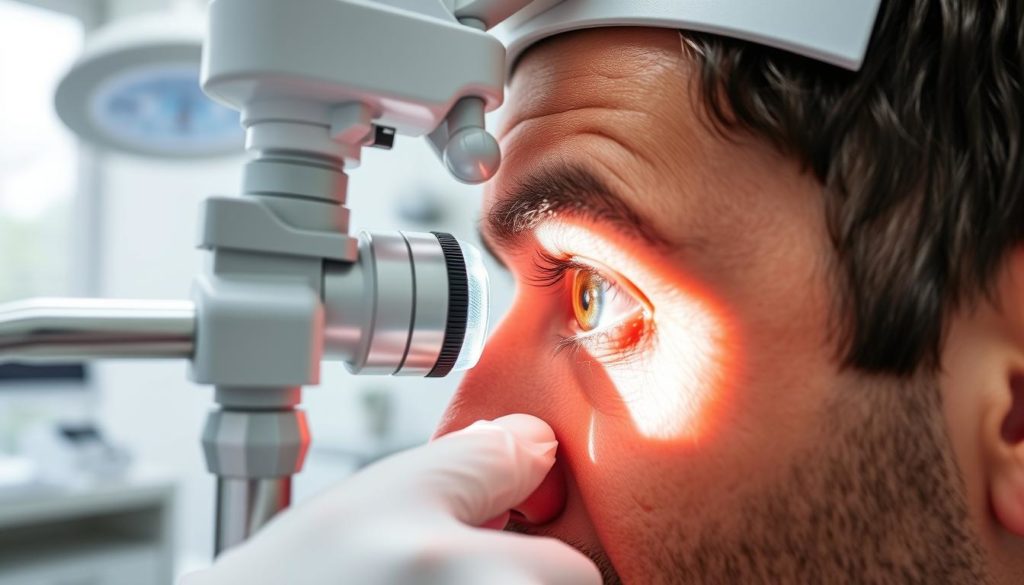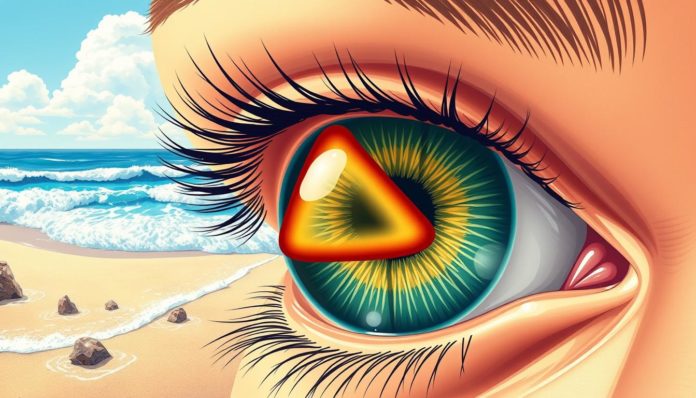Did you know nearly 12% of people near the equator get pterygium, or Surfer’s Eye? This condition shows as a pink, fleshy growth on the eye. It’s common in those who are often outdoors.
Pterygium happens from too much UV light, dust, and wind. These are usual in sunny places close to the equator. If not treated, it can grow over the cornea and harm your sight.
It’s important to understand pterygium for keeping your eyes healthy. This guide will tell you what it is, why it happens, and how to treat it. Knowing about Surfer’s Eye helps protect your vision.
What is Pterygium?
Pterygium is also called Surfer’s Eye. It’s a noncancerous growth on the clear covering of the eye, known as the conjunctiva. It usually forms near the nose or toward the side of the eye. This growth can spread across the white part of the eye and might reach the pupil, affecting vision. It often happens due to UV damage from spending lots of time outdoors without eye protection.

Definition and Overview
Pterygium has a triangular shape and begins on the conjunctiva near the cornea. It can grow toward the eye’s center. How we treat pterygium depends on how serious it is. Treatments range from using eye drops to surgery. Checking your eyes regularly helps manage this condition and prevents more UV damage.
Common Names: Surfer’s Eye
It’s called Surfer’s Eye because it’s common in people exposed to lots of sun, wind, and dust. This condition shows why wearing eye protection is key during outdoor activities. Wearing UV-blocking sunglasses is an easy step to reduce your risk.
Pterygium vs Pinguecula
Pterygium and pinguecula both stem from UV light and being out in harsh environments, but they are different. Pterygium can grow over the cornea and mess with how we see. On the other hand, pinguecula is a yellow bump that stays off the cornea. Taking care of your eyes and protecting them are important for both issues.
| Aspect | Pterygium | Pinguecula |
|---|---|---|
| Appearance | Triangular growth extending onto the cornea | Yellowish bump on the conjunctiva |
| Effect on Vision | Can impair vision | Usually does not affect vision |
| Causes | UV exposure, wind, dust | UV exposure, dry eyes |
| Treatment | Topical medications, surgery | Lubricating eye drops, UV protection |
Causes of Pterygium
Pterygium often starts due to many factors. Each of these plays a key role in affecting eye health. They can significantly influence how our eyes grow.
UV Radiation Exposure
UV radiation from the sun is a big cause of pterygium. Being outdoors a lot without good eye protection can make it worse. The harmful rays make this eye condition develop and get worse.

Environmental Irritants
Things like dry, windy weather, and dust also play a part. They can make the surface of our eyes inflamed. This can lead to pterygium and other eye problems.
Geographical Location
Where you live matters too. Places with a lot of sun have more pterygium cases. People in these areas face more risk because of more intense UV rays.
Genetic Factors
Your family history is important too. If your family has had it, you’re more likely to get it. This is especially true for men between 20 and 40. Genetics and environment together can make eye growth worse, impacting eye health.
| Cause | Description |
|---|---|
| UV Radiation Exposure | Prolonged exposure to UV rays without proper eye protection. |
| Environmental Irritants | Exposure to dry, windy conditions and dust. |
| Geographical Location | Living in sun-rich areas known as the “pterygium belt.” |
| Genetic Factors | Family history and genetic predisposition, particularly in males aged 20-40. |
Symptoms of Surfer’s Eye
Pterygium symptoms can range from mild to severe. Common signs give a clear hint of this eye condition. It usually starts on the conjunctiva and may reach the cornea. This causes a lot of eye irritation and vision problems.
Visible Growth
A big clue of pterygium is a growth on the eye’s white part. It often stretches towards the cornea. The size can change and it’s usually closer to the nose.
Redness and Irritation
Pterygium often brings eye irritation and redness. Wind, dust, or other irritants can make these symptoms worse. This adds to the discomfort people feel.
Foreign Body Sensation
Feeling like something is in the eye is a common symptom of pterygium. It feels like sand or grit in the eye. This leads to constant unease and a lot of blinking. Such issues make it hard to keep up with visually demanding tasks.
Blurred or Distorted Vision
If the growth spreads to the cornea, vision can blur or distort. This greatly impacts daily life and requires quick medical help.
Risk Factors for Pterygium
Knowing the pterygium risk factors is key for eye health. Being out in the sun, especially for outdoor lovers like surfers, increases risk. The sun’s UV rays hurt the eye’s surface, so wearing sunglasses outside is vital.
Wind, dust, and smoke pose additional threats. These environmental irritants worsen the chances of getting pterygium. People in sunny or tropical places face higher risks too.
Family history also plays a role. If your family has had pterygium, you might get it, especially men aged 20 to 40. Knowing these pterygium risk factors helps in prevention and keeping eyes healthy.
Diagnosis and Examination
Diagnosing pterygium, or surfer’s eye, involves many steps. A Pterygium diagnosis starts with a full eye exam. It checks how well you see and how your eyes move.
Comprehensive Eye Examination
An in-depth eye exam is key to understanding pterygium. It checks your sight and eye movements. This ensures the growth hasn’t limited your eye movement.
Slit Lamp Analysis
A slit lamp analysis gives a closer look. A special microscope lights up and enlarges the eye’s view. Optometrists examine the conjunctiva and cornea closely. This test reveals the pterygium’s size, shape, and location for a correct diagnosis.
Imaging Techniques
Advanced imaging like AS-OCT provides detailed eye images. These images show the growth’s depth and size. Another method, corneal topography, maps the eye’s surface in 3D. These tools improve Pterygium diagnosis quality. They help create a suitable treatment plan.
| Diagnostic Method | Purpose | Details |
|---|---|---|
| Eye Examination | Initial Assessment | Evaluates visual acuity and eye mobility |
| Slit Lamp Analysis | Detailed Examination | Magnifies and illuminates the eye for detailed analysis |
| Imaging Techniques | Advanced Imaging | Uses AS-OCT and corneal topography to create eye structure images |
Pterygium Treatment Options
Managing pterygium, commonly known as Surfer’s Eye, involves a range of treatments. These treatments match the condition’s severity and the patient’s symptoms. Effective treatment can be simple or involve advanced surgical methods.
Conservative Management
For those with mild symptoms, starting with conservative management is often best. This can include using lubricating eye drops or anti-inflammatory meds. These steps can ease discomfort and lower inflammation, helping keep the eyes healthy.
Surgical Removal
If mild treatments don’t work, or if the pterygium severely affects vision or looks, surgery may be needed. Surgical methods usually remove the pterygium. They often add a tissue graft to lower the chance of it coming back. This combination is very effective for treating pterygium.
Post-Surgical Care
After surgery, careful post-surgical care is critical for healing and to avoid regrowth. This care often involves steroid eye drops and other specific medications. Good post-surgical care is crucial. It can last from a few weeks to a year, ensuring the eyes return to their best health.
Pterygium (Surfer’s Eye) Prevention
Preventing Pterygium is key for those who love the outdoors. The best way to prevent it is using UV protection. Wear sunglasses that block almost all UVA and UVB rays. It’s important to note wraparound sunglasses offer the best defense against UV light, dust, and wind.
Wearing sunglasses is a big step in eye care. But adding other safety measures is a good idea. Using artificial tears keeps the eyes moist in dry places. This helps stop the dryness that might make Pterygium worse. Also, wearing hats with wide brims protects your eyes from the sun.
Using sunglasses, hats, and artificial tears boosts your protection against UV rays. It also cuts down the chance of getting Pterygium. Making these practices part of your daily life helps keep your eyes healthy. It also prevents future eye problems.
When to Consider Surgery for Pterygium
Sometimes, non-surgical treatments don’t help, or the pterygium might affect your vision. Knowing surgical indications, the types of surgeries, and recovery helps make a good choice.
Indications for Surgery
Surgery might be needed when other treatments don’t work. Reasons include:
- Ineffectiveness of eye drops
- Obstruction of vision
- Development of astigmatism
- Unsatisfactory cosmetic appearance
Types of Pterygium Surgery
Different surgeries cater to varying needs:
- Excision with Conjunctival Autograft: It’s low-risk for coming back.
- Amniotic Membrane Graft: Good for big pterygia due to healing benefits.
- Simple Excision: Enough for smaller pterygia.
Pterygium Removal Recovery
After surgery, wearing an eye patch reduces pain and protects the eye. Critical post-op care includes:
- Watching for regrowth
- Using eye drops to prevent infection and lessen swelling
- Staying away from dust and wind
- Regular eye exams for a year
Knowing the surgery options and recovery is key. Each surgery type offers different advantages.
Managing Pterygium at Home
Dealing with pterygium, also known as surfer’s eye, can make you feel better at home. Wearing protective sunglasses is a top tip for caring for your eyes. They protect against UV rays and irritants, stopping the pterygium from growing.
Artificial tears and lubricating ointments help soothe pterygium symptoms. Using eye drops regularly keeps your eyes moist and less irritated. For worse discomfort, your eye doctor may suggest nonsteroidal anti-inflammatory drugs or steroid eye drops. Always talk to a healthcare professional before trying stronger treatments.
Natural methods can help, too. Rosewater compresses may reduce irritation because of their soothing effects. Honey drops and washes with rose and Trifla water are age-old eye care techniques. However, use them wisely and under an eye specialist’s advice, especially for serious or ongoing symptoms.
FAQ
What is a pterygium and why is it called Surfer’s Eye?
Pterygium, or Surfer’s Eye, is a pink, fleshy tissue growth. It grows on the conjunctiva, which covers the white part of the eye and lines the eyelids. It’s known as Surfer’s Eye because it’s common in people who spend lots of time outside, like surfers. They are often exposed to UV light, wind, and dust.
How does a pterygium differ from a pinguecula?
A pterygium and a pinguecula are both caused by UV exposure. However, a pterygium is a growth that can move onto the cornea and affect vision. On the other hand, a pinguecula is a yellowish growth. It stays on the white part of the eye and doesn’t spread to the cornea.
What causes pterygium?
The main causes of pterygium include UV radiation, wind, dust, and dry weather. There’s also a higher chance of getting it in places close to the equator, in the “pterygium belt.”
What are the common symptoms of Surfer’s Eye?
Common symptoms include a growth on the eye and redness. People may feel like there’s something in their eye. They can also experience dryness, itchiness, burning, and, if it gets worse, blurred or double vision.
Who is most at risk for developing pterygium?
People with a lot of UV exposure are at higher risk, especially those who are often outdoors in sunny or windy places. Men aged 20 to 40 and individuals with a family history of the condition are more likely to get it.
How is pterygium diagnosed?
Doctors diagnose pterygium with an eye exam. They check the eye’s visual acuity and use a slit lamp. They might also use imaging techniques like AS-OCT to see how the growth affects the eye.
What are the treatment options for pterygium?
Treatments include using lubricating drops and anti-inflammatory medicines. In severe cases, doctors may suggest surgery. The surgery removes the growth. Then, they do a graft to lower the chance of it coming back.
How can pterygium be prevented?
To prevent pterygium, wear sunglasses that block UVA and UVB rays. Use artificial tears and wear hats for extra shade when outside.
When should I consider surgery for my pterygium?
Consider surgery if drops don’t work, the growth blocks vision, causes astigmatism, or looks bad to you. Your eye doctor will guide you based on how it affects your vision and symptoms.
What does home management of pterygium involve?
Home care includes protective sunglasses and artificial tears. Some may use lubricating ointments and prescribed anti-inflammatory drugs or steroids. Natural remedies, like rosewater or honey drops, might help but talk to an ophthalmologist first.


